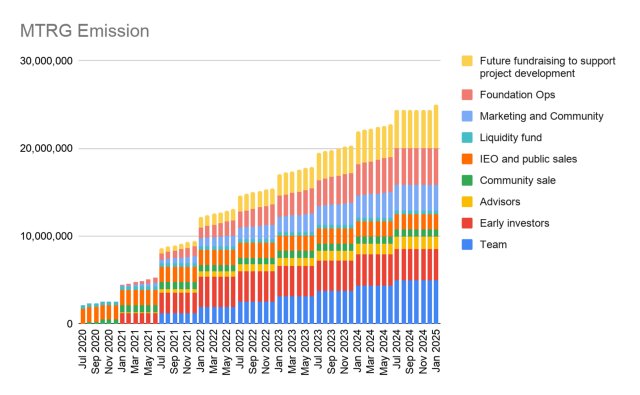
1) In today's market it's difficult to select high quality cryptocurrencies.
Most fade away and as such we need to search for the best fundamentals.
A thread on $MTRG and why you should take a look at this cryptocurrency.
Read on 🧵👇
@Meter_IO #Meter #Mtrg
Most fade away and as such we need to search for the best fundamentals.
A thread on $MTRG and why you should take a look at this cryptocurrency.
Read on 🧵👇
@Meter_IO #Meter #Mtrg

2) Meter is a DeFi infrastructure with a built-in currency called MTR.
It uses a "HotStuff" based Proof of Stake consensus with MTRG as a governance Token to manage the blockchain ledger.
Meter functions as a highly-decentralized, high-performance side chain for other chains.
It uses a "HotStuff" based Proof of Stake consensus with MTRG as a governance Token to manage the blockchain ledger.
Meter functions as a highly-decentralized, high-performance side chain for other chains.
3) Meter is working to achieve three things with Meter’s DeFi infrastructure:
• Complete Bitcoin’s original vision and create a stable currency independent of the fiat system.
• Address performance issues.
• Run as a side chain to enable scaling and value interaction.
• Complete Bitcoin’s original vision and create a stable currency independent of the fiat system.
• Address performance issues.
• Run as a side chain to enable scaling and value interaction.
4) Meter is extremely high performance with thousands of transactions per second.
It has instant finality with an average block time of 2.4 seconds.
It's also MEV front-run resistant and is already functioning as a cross chain bridge supporting many networks.
It has instant finality with an average block time of 2.4 seconds.
It's also MEV front-run resistant and is already functioning as a cross chain bridge supporting many networks.
5) Meter chain is quite unique as unlike other layer ones and Layer twos, Meter has a low volatility coin to pay the gas fees.
It uses a Proof of Work consensus algorithm to mine MTR and is pegged to the cost of 10kwh of elektricity.
It uses a Proof of Work consensus algorithm to mine MTR and is pegged to the cost of 10kwh of elektricity.

6) The second coin MTRG uses Proof of Stake to validate transactions.
This is the governance token and has the following uses:
• Stake to earn MTR
• Earn fees
• Usage in future DeFi apps
• Participate in governance
This is the governance token and has the following uses:
• Stake to earn MTR
• Earn fees
• Usage in future DeFi apps
• Participate in governance
7) The reason for the dual tokens is to separate the economic consensus (MTR) from the record keeping consensus (MTRG).
Transactions that meet the gas requirement are ordered based on the time the network receives them and not the gas price, making it MEV and frontrun resistant.
Transactions that meet the gas requirement are ordered based on the time the network receives them and not the gas price, making it MEV and frontrun resistant.
8) Meter can theoretically have unlimited scalability with sharding and further sidechains.
Because of MTR, transaction costs are relatively stable. No worry about transaction costs rising with the rise in price of the underlying blockchain token.
Because of MTR, transaction costs are relatively stable. No worry about transaction costs rising with the rise in price of the underlying blockchain token.
9) METER PASSPORT
Meter aims to be interoperable with other chains. This is where Meter Passport comes into play as a bridge.
The current list of supported chains can be seen in the image below.
Meter aims to be interoperable with other chains. This is where Meter Passport comes into play as a bridge.
The current list of supported chains can be seen in the image below.

10) The bridge fee between chains is very minimal.
The great thing is that bridge fees are subsidised.
Either MTR or MTRG are dropped to your wallet depending on the chain you are bridging to, to help cover some of the bridge costs.
The great thing is that bridge fees are subsidised.
Either MTR or MTRG are dropped to your wallet depending on the chain you are bridging to, to help cover some of the bridge costs.
11) Meter Passport not only allows smart contracts to transfer assets between chains but also allows smart contracts to communicate across blockchains.
Meter was built with DeFi in mind. It already hosts a decentralised cross chain exchange called VoltSwap.
Meter was built with DeFi in mind. It already hosts a decentralised cross chain exchange called VoltSwap.

12) TOKENOMICS
16.5 million tokens are currently in circulation with a total supply of 40M.
15 million tokens of those are reserved for future products.
This means untill early 2025 we'll see a slow MTRG emission from token unlocks.
See the image below.
16.5 million tokens are currently in circulation with a total supply of 40M.
15 million tokens of those are reserved for future products.
This means untill early 2025 we'll see a slow MTRG emission from token unlocks.
See the image below.

13) CONCLUSION
With more and more chains being supported, Meter can help scale many protocols and dApps if they decide to use Meter’s side chain.
Using it's dual consensus mechanism Meter is believed to be one lf the most decentralized protocols in the market.
With more and more chains being supported, Meter can help scale many protocols and dApps if they decide to use Meter’s side chain.
Using it's dual consensus mechanism Meter is believed to be one lf the most decentralized protocols in the market.
14) With the incredible high number of layer 1 and Layer 2 blockchains popping up, Meter could see a serious rise in adoption as they could directly benefit from this protocol.
I for one can't wait to see how they will develop.
Nova out ❤️
@CryptoWizardd @AdamHODL
I for one can't wait to see how they will develop.
Nova out ❤️
@CryptoWizardd @AdamHODL
15) If you want to keep up to date to most of my content and interesting projects give me a follow @CryptoGirlNova.
I also research the communities top voted cryptocurrency every week so you can keep track of all the most exciting projects.
Your favorite writer Nova 📘
I also research the communities top voted cryptocurrency every week so you can keep track of all the most exciting projects.
Your favorite writer Nova 📘
16) If you had value from this and liked this thread, it would really bring a smile to my face if you could retweet the first post so this can help as many people as possible.
Everyone deserves free knowledge 📘
Love you all ❤️
First post 👇
Everyone deserves free knowledge 📘
Love you all ❤️
First post 👇
https://twitter.com/CryptoGirlNova/status/1574521694571618313?t=d4d2bwFGbO8n-jzo5_oYHg&s=19
• • •
Missing some Tweet in this thread? You can try to
force a refresh












